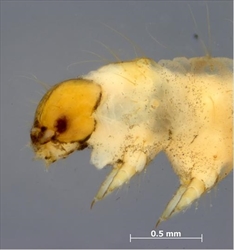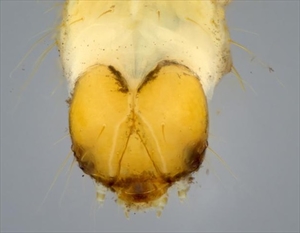Background
The Yponomeutidae is a relatively small family of around 400 named species; most are found in the tropics, and there are 50 known Australian species. Ermine moths are small to medium-sized and the species are diverse in morphology and biology. Caterpillars are diverse in lifestyle and include leaf-webbers, leaf skeletonisers, leafminers, needleminers and fruit borers. Some species are considered to be minor pests in agriculture, horticulture and forestry.
Short Description
Caterpillars from this family are small at around 15 mm in length, maximum. They tend to be colourful, often with longitudinal stripes. They are leafminers but also attack flowers and bore into fruit and seeds. The caterpillars are not hairy, as they only have primary setae; although these can be relatively long (Fig. 1). They sometimes feed externally and may form communal webs with large amounts of silk (Fig. 2).
Diagnosis
Adapted from Dugdale et al. (1999) and Stehr et al. (1987)
- Thoracic legs – the pretarsus or claw is unusually long and straight. In Yponomeutidae, but absent in the Argyresthiinae (Fig. 3).
- Abdominal segments with SD2 absent. In Argyresthiinae.
- A10 – excluding the suranal shield, with not more than nine setae on each side. In Argyresthiinae.
- Prolegs
- Crochets
- multiserial circle. In Yponomeutinae.
- uniserial. In Argyresthiinae.
- Crochets
Detailed Description
Adapted from Stehr et al. (1987).
Head: The head is hypognathous (Fig. 3). The frontoclypeus is higher than wide extending about two-thirds to the epicranial notch (Fig. 4). There are six stemmata arranged in an oblique rectangle with 1 and 2 dorsad and 5 and 6 ventrad of seta S1. Sometimes there is a gap between two and three.
Thorax: The prothoracic shield is usually well-developed and pinacula are variably coloured but often brown. T1 – The L group is trisetose as is typical for Microlepidoptera (rarely bisetose e.g. Ocnerostoma (Yponomeutinae).)
Abdomen: L2 is anteroventrad of L1 on A1-A8, distant from each other and on separate pinacula, and distant from L3. SD1 is anterodorsad to the spiracle on A1-A8. D2s are closer together than D1s on A9. L1 and L2 are approximate on A9 and on one pinaculum. A10 usually has a well-developed suranal shield.
Prolegs are normal and present on A3-A6 and A10 (Fig. 1). Crochets are uniordinal in multiserial circles but are uniserial in Argyresthiinae, and rarely biserial.
Species of Biosecurity Concern
THE FOLLOWING SPECIES IS OF BIOSECURITY CONCERN TO NORTHERN AUSTRALIA
This species is of biosecurity concern to northern Australia. It feeds on citrus fruit and is an important pest of pomelo in Vietnam. Little information is available on the larvae.
Prays endocarpa (citrus pock caterpillar, citrus fruit moth, citrus rind borer) (Yponomeutidae: Praydinae)
Description
To be updated. At this stage very little information is available on immature stages, including images.
Diagnosis
As above.
Biology and Feeding Damage
Early instar caterpillars mine the peel of citrus fruit such as pomelos, causing premature fruit fall and/or creating gall-like swellings on the fruit surface (pocks) (Vang et al. 2018). Larval development is completed in the galls; the larvae never leave the endocarp. The mature caterpillar leaves the fruit through an exit hole before pupating on the outer surface of the fruit or on twigs and leaves.
Current Distribution
- India
- Southeast Asia Vietnam
- Pacific region
See (EFSA 2008): https://efsa.onlinelibrary.wiley.com/doi/pdf/10.2903/j.efsa.2008.681
Caterpillar Host Plants
- citrus fruit including pomelo (Citrus grandis), oranges, mandarins, lemons, limes, and grapefruit
- other Rutaceae including the bael tree (Aegle marmelos)
From EFSA (2009). https://efsa.onlinelibrary.wiley.com/doi/pdf/10.2903/j.efsa.2008.681
References
Dugdale, J. S., Kristensen, N. P., Robinson, G. S. & Scoble, M. J. (1999) The Yponomeutoidea. In: Kristensen, N.P. (Ed.), Handbook of Zoology. 4 (35.1). De Gruyter, Berlin, New York.
European Food Safety Authority (EFSA) (2008). Pest risk assessment made by France on Prays endocarpa considered by France as harmful in French overseas departments of French Guiana, Guadeloupe, Martinique and Réunion1. Scientific Opinion of the Panel on Plant Health. The EFSA Journal, 681: 1-16. https://efsa.onlinelibrary.wiley.com/doi/pdf/10.2903/j.efsa.2008.681
MAF Plant Health & Environment Laboratory (2011) Citrus Flower Moth (Prays nephelomima) Updated on 4/17/2014 1:39:37 AM Available online: PaDIL - http://www.padil.gov.au
Stehr, F.W., Martinat, P.J., Davis, D.R., Wagner, D.L., Heppner, J.B., Brown, M.E., Toliver, M.E., Miller, J.Y., Downey, J.C., Harvey, D.J., McFarland, N., Neunzig, H.H., Godfrey, G.L., Habeck, D.H., Appleby, J.E., Jeffords, M., Donahue, J.P., Brown, J.W. & Frack, D.C. (1987) Order Lepidoptera, pp 288–596. In Stehr, F. W. (Ed.), Immature Insects. Kendall/Hunt, Dubuque.
Vang, L.V., Son, P.K. and Khanh, C.N.Q., 2018. Monitoring population dynamics of the citrus pock caterpillar (Prays endocarpa) by sex pheromone traps in the Mekong Delta of Vietnam. Can Tho University Journal of Science. 54(2): 35-39.




